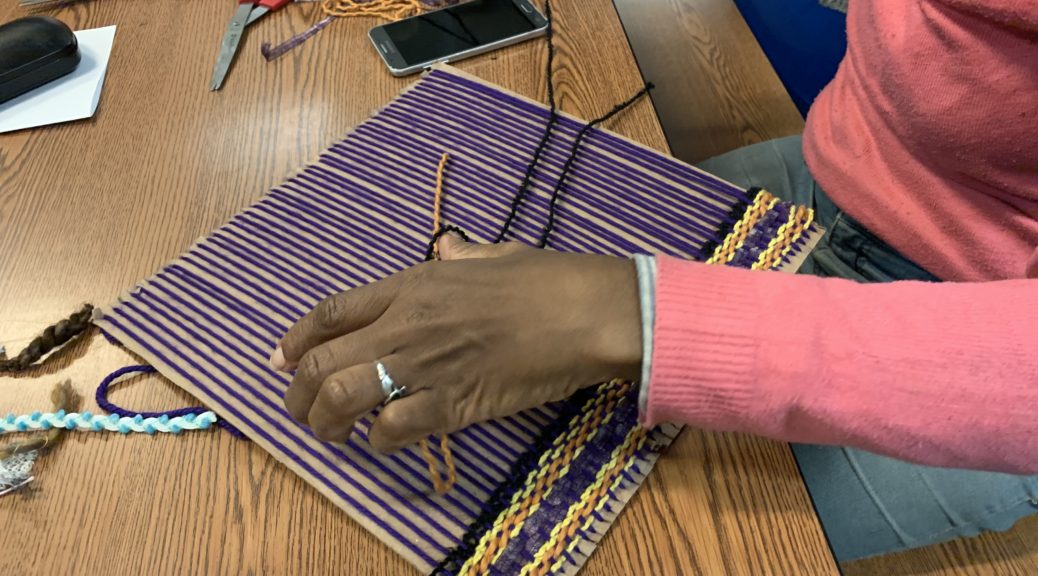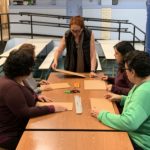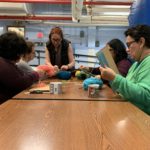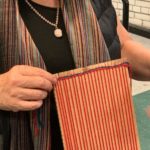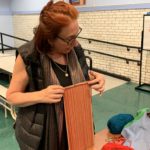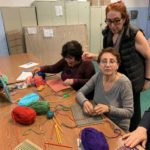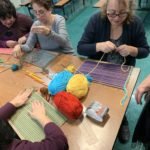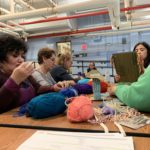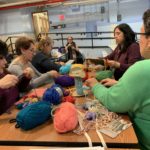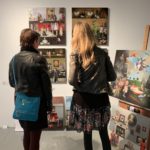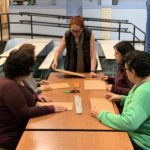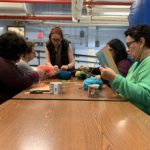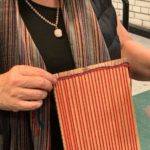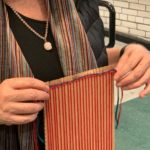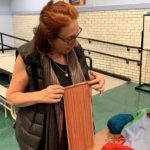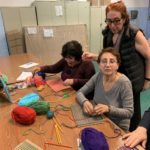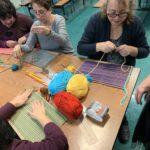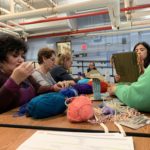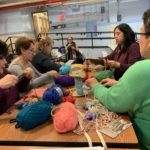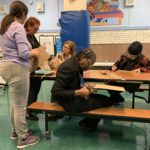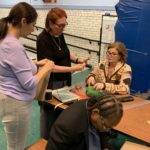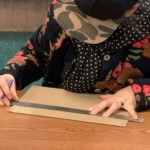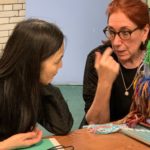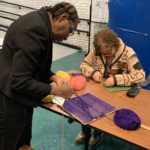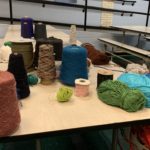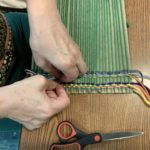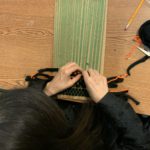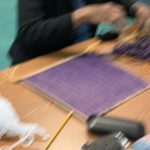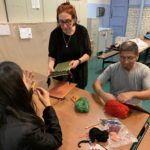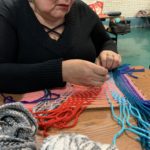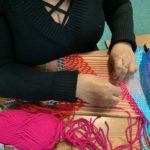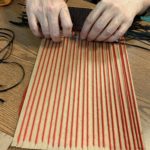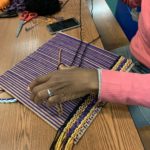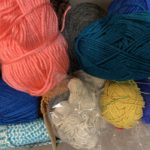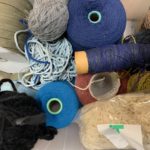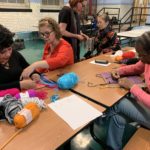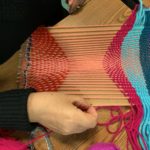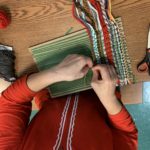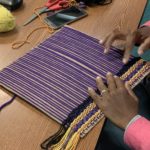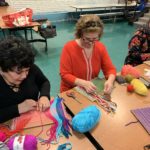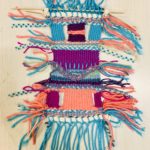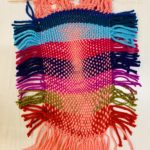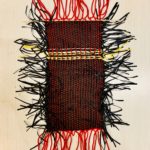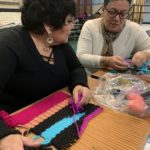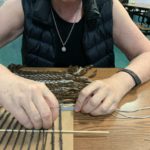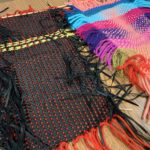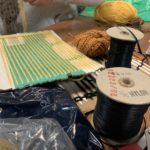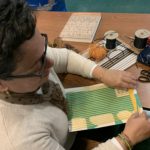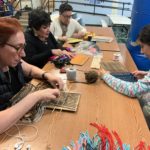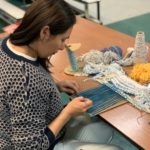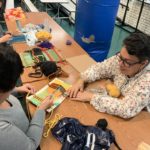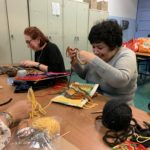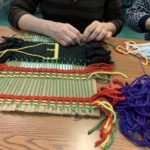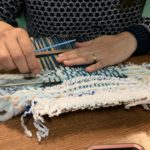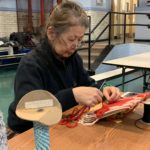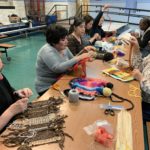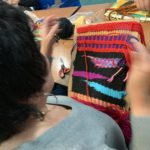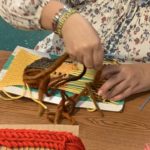Introducción a la práctica del tejido textil para aprender su relevancia cultural. Primero, exploraremos algunos términos y conceptos y especialmente la noción de que el tejido textil está presente en todas las culturas, pasadas y presentes. Los participantes descubrirán lo que significa participar de una tecnología antigua y cómo pueden convertirse en parte de una tradición universal. Abordaremos preguntas tan básicas como ¿qué es un tejido textil? ¿Qué mantiene una superficie unida? O consideraciones más sofisticadas tal como, ¿cuál es la relación entre tradición e innovación, el trabajo a mano versus a máquina? ¿O plantearemos la pregunta si la función de un objeto puede cambiar la intención estética, y viceversa? Después de hacer visible la conexión con el pasado y la relevancia cultural que puede tener el tejido textil hoy, los participantes se centrarán en la relación entre la superficie y el diseño desde diferentes ángulos.
Descripción:
Los participantes aprenderán cómo crear una superficie tejiendo hilos de diferentes texturas utilizando un cartón de soporte. Este método de producción textil facilita el manejo de los hilos entrelazados para formar una tela que puede convertirse en una obra de arte o en un objeto funcional como una bufanda, un sombrero, un bolso de mano ++++. Aprenderán el propósito de usar los hilos verticales o hilos llamados urdimbre y cómo diseñar los horizontales llamados trama. En el proceso descubrirán que materiales y procesos similares presentan desafíos que pueden tener diferentes soluciones.
Educadora:
Cynthia Capriata es una artista visual nacida en Perú radicada en Nueva York, educadora de arte y especialista pedagógica en diseño curricular para educación artística K-12 y en el desarrollo de instrumentos de evaluación docente. Tiene un BFA de The School of Visual Arts, una maestría en arte y educación artística (2003) y EdM en educación con concentración en artes visuales (2005) de Teachers College, Columbia University, Nueva York. Tiene experiencia en la enseñanza de artes visuales en escuelas de grado K-8, así como talleres de artes visuales e historia del arte para estudiantes universitarios. La Fundación Robert Rauschenberg (2004) la reconoció por su trabajo de integración de artes visuales y ciencias sociales con estudiantes de educación especial. Desde 1982 participa en exposiciones individuales en galerías en Lima y en otras regiones del Perú como Trujillo, Iquitos y Arequipa. Internacionalmente ha expuesto en Nueva York, París y Abu Dhabi, donde vivió durante 5 años. En sus obras de arte, está interesada en desarrollar reflexiones visuales que crucen fronteras imaginarias, sociales y culturales.
Plan de Estudios:
Semana 1, Introducción: conceptos y procesos
B. Objetivo de aprendizaje: los participantes podrán:
• Comprender la relevancia cultural del tejido (cultural universal)
• Imagine formas creativas de usar procesos simples (arriba y abajo) y materiales (hilos de diferente grosor y textura)
• Cree el comienzo de una superficie tejida a mano entrelazando hilos verticales y horizontales en ángulo recto utilizando un cartón rectangular como telar (para soporte).
• Trazar una idea inicial para el diseño de tejido seleccionando hilos de diferentes texturas, posiblemente patrones …?
C. Pregunta guía o principio de organización:
• ¿Qué es tejer? (el entrelazado de 2 grupos distintos de hilos en ángulo recto) ¿Qué elementos son esenciales para tejer a mano? (la intersección de horizontal y vertical de 2 sistemas separados de hilos) ¿Qué procesos mantienen una superficie unida? (el principio de la construcción textil se divide en 3 formas básicas de tejido o cualquier combinación: el tejido liso, la tela cruzada y el tejido de satén. (Vamos a practicar el tejido liso que se remonta en el tiempo más atrás y es el más simple) crear. Dependiendo del interés de los participantes, podríamos incluir detalles del tejido de sarga que forma un patrón. Veremos ejemplos del tejido satinado …)
D. Actividades:
• Introducción al tejido: relevancia cultural, breve historia, nombres y procesos.
• Preparación de hilos de urdimbre en el telar.
• Proyecto de diseño
E. Reflexión:
• Revisar conceptos y procesos: ¿Qué es un warp? ¿Qué es la trama? ¿Voy a seguir un diseño o elegir un enfoque espontáneo más libre para tejer? ¿Ya estoy pensando en el color y la textura? Consideraciones importantes para reflexionar después de la primera clase.
Semana 2, Tejido: organización de materiales y procesos
B. Objetivo de aprendizaje: los participantes podrán:
• Vea una variedad de ejemplos de tejido para deconstruir procesos y diseños
• Comprender cómo las diferentes formas de hilos que se cruzan forman tipos distintivos de tejidos (diseños)
• Gana experiencia entrelazando hilos y los efectos de cómo se cruzan: los hilos de urdimbre son estacionarios y verticales, los hilos de trama son horizontales y en movimiento, cruzan debajo / sobre los hilos de urdimbre en ángulo recto (discutiremos las variaciones …)
• Planifique cuidadosamente cómo combinar hilos y procesos para soporte estructural
• Cree una estructura firme prestando atención a la tensión entre los hilos de urdimbre y los hilos de trama
C. Pregunta guía o principio de organización:
• ¿Cuáles son los patrones? ¿Cuál es la estructura de una tela o su tejido? (según Ani Albers, la forma en que los hilos se unen entre sí es tan determinante en su función como lo es la elección de las materias primas). ¿Pueden diferentes técnicas compartir los mismos elementos? ¿Cuáles son las técnicas de elemento único? (bucles, redes, tejer, crochet). ¿Cuáles son las técnicas de elementos múltiples? (anudado, enrollado, torcido, trenzado).
D. Actividades:
• Continuar tejiendo organizando la superficie de acuerdo con la técnica y las diferentes exploraciones.
• ¿Qué es rya? (anudado en la alfombra que se encuentra al final de un tejido para crear una franja. Sin embargo, el nudo rya también se puede colocar como parte del diseño para crear una composición más única.
E. Reflexión:
• Revise la selección de hilos y vea si surgen patrones.
• Reflexione sobre el color, los patrones y las texturas que se agregan a su tejido.
• ¿Vas a incluir algún nudo rya?
Semana 3 Desafío de diseño
B. Objetivo de aprendizaje: los participantes podrán:
• Aprenda que los materiales y procesos similares presentan desafíos que pueden tener diferentes soluciones.
• Examinar críticamente el diseño.
• Pensar y decidir: ¿mi tejido se convertirá en un objeto funcional o seguirá siendo una obra de arte para ser juzgado exclusivamente por sus cualidades estéticas?
C. Pregunta guía o principio de organización:
• ¿Cuál es la esencia del tejido? (la interrelación entre la fijación de sus elementos de hilos entre sí y la elección de las materias primas, Ani Albers) ¿Qué pasa con su función? ¿La función de un objeto cambia el significado de su intención estética? (y viceversa).
D. Actividades:
• Continuar tejiendo
• Ajuste el tejido a la intención y al nuevo propósito o proceso
• Compartir experiencias con compañeros
E. Reflexión:
• ¿Cómo puedo crear un tejido más fuerte? (tensión) O al contrario, ¿cómo puedo mantener los elementos fluidos, con espacios vacíos entre …?
• Revisar procesos con pares
Semana 4 : Construcción de materiales y procesos; si es necesario, comience un nuevo tejido o fragmento 3D en un telar de cartón separado para agregar a su diseño original
B. Objetivo de aprendizaje: los participantes podrán:
• Aprenda que las opciones creativas pueden seguir caminos inesperados y que materiales y procesos similares presentan desafíos que pueden traer diferentes soluciones
• Comprender qué elementos y acciones funcionan mejor para sostener la estructura del tejido
• Planifique con anticipación para aprender cómo combinar hilos y procesos para soporte estructural
Semana 5 Transformando la urdimbre o creando un nuevo diseño en telar separado
B. Objetivo de aprendizaje: los participantes podrán:
• Reflexionar sobre / fortalecer la formación original del diseño a través de la urdimbre
• Considere ajustar / agregar dónde y cómo se entrelazan el sistema de hilos
• Comprender qué elementos y acciones funcionan mejor para sostener la estructura del tejido
• Observe cuidadosamente la estructura del tejido para aprender que las acciones individuales pueden contribuir a hacer un diseño más complejo.
C. Pregunta guía o principio de organización:
• ¿Puede la urdimbre ser creativa en relación con la trama? ¿Qué principio debe seguir siendo el mismo? ¿Cómo se puede elaborar más la construcción textil de la urdimbre?
D. Actividades:
• Continuar tejiendo siguiendo el flujo de nuevos descubrimientos.
• Mejora visualmente la calidad estética de la urdimbre (opcional)
E. Reflexión:
• Comparta una experiencia, desafío o algo positivo / negativo
• ¿Que aprendi?
Semana 6 Termine de tejer
B. Objetivo de aprendizaje: los participantes podrán:
• Saca el tejido del telar.
• Doble nudo los hilos de urdimbre
• Presente el tejido a sus compañeros y exhiba en clase
• Tejer fotografías
C. Pregunta guía o principio de organización:
• ¿Por qué los principios básicos del tejido han permanecido iguales con el tiempo? … incluso después de que fue mecanizado? (los fundamentos de la construcción de tejidos tienen un “carácter universal y se usan hoy, como lo fueron en nuestra historia temprana, aquí y en todas partes”, Ani Albers). ¡¡Todas las culturas han tenido procesos de tejido !!!!!!!!!!
D. Actividades:
• Finalice el proyecto atendiendo a los detalles finales asegurándose de anudar doblemente todos los hilos de envoltura
E. Reflexión:
• Compartir la experiencia del proceso.
Este curso ha sido disenado y creado por la profesora y artista Cynthia Capriata.
Week One, Intro: concepts and processes
B. Learning Objective: Participants will be able to:
• Understand the cultural relevance of weaving (cultural universal)
• Imagine creative ways to use simple processes (up and down) and materials (threads of different thickness and texture)
• Create the beginning of a hand-woven surface by interlacing vertical and horizontal threads at right angles using rectangular cardboard as a loom (for support).
• Map out an initial idea for the weaving design selecting threads of different textures, possibly patterns…?
C. Guiding Question or Organizing Principle:
• What is weaving? (the interlacing of 2 distinct groups of threads at right angles) What elements are essential for handmade weaving? (the intersecting of horizontal and vertical of 2 separate systems of threads) What processes keep a surface together? (the principle of textile construction falls under 3 basic ways of weaving or any combination: the plain weave, the twill, and the satin weave. (We are going to practice the plain weave which goes back in time the furthest and is the simplest to create. Depending on the interest of the participants we could include details of twill weaving which forms a pattern. We will see examples of the satin weave…)
D. Activities:
• Intro to weaving: cultural relevance, brief history, names and processes
• Preparation of warp threads in the loom
• Design project
E. Reflection:
• Review concepts and processes: What is a warp? What is the weft? Am I going to follow a design or choose a freer spontaneous approach to weaving? Am I thinking of color and texture already? Important considerations to reflect upon after the first class.
Week 2, Weaving: organizing materials and processes
B. Learning Objective: Participants will be able to:
• See a variety of weaving examples to deconstruct processes and designs
• Understand how the different manners of intersecting threads form distinctive kinds of weaves (designs)
• Gain experience interlacing threads and the effects of how they intersect: the warp threads are stationary and vertical, the weft threads are horizontal and in motion, they cross under/over the warp threads at right angles (we will discuss variations…)
• Plan carefully how to combine threads and processes for structural support
• Create a firm structure paying attention to the tension between the warp threads and the weft threads
C. Guiding Question or Organizing Principle:
• What are the patterns? What is the structure of a fabric or its weave? (according to Ani Albers, the way the threads are fastened to one another is as much a determining factor in its function as is the choice of the raw materials). Can different techniques share the same elements? What are the single element techniques? (looping, netting, knitting, crocheting). What are the multiple-element techniques? (knotting, coiling, twining, braiding).
D. Activities:
• Continue weaving organizing the surface according to technique and different explorations
• What is rya? (rug knotting found at the end of a weave to create a fringe. However, the rya knot can also be placed as part of the design to create a more unique composition.
E. Reflection:
• Review the selection of threads and see if there are any patterns that come up.
• Reflect on what the color, the patterns, and the textures are adding to your weave.
• Are you going to include any rya knots?
Week 3 Design challenge
B. Learning Objective: Participants will be able to:
• Learn that similar materials and processes present challenges that may have different solutions
• Critically examine design
• Think and decide: Will my weaving turn into a functional object or will it remain an artwork to be judged exclusively by its aesthetic qualities?
C. Guiding Question or Organizing Principle:
• What is the essence of weaving? (the interrelation between the fastening of its elements of threads to each other and the choice of raw materials, Ani Albers) What about its function? Does the function of an object change the meaning of its aesthetic intention? (and vice versa).
D. Activities:
• Continue weaving
• Adjust weaving to intention and new purpose or process
• Share experience with peers
E. Reflection:
• How can I create a stronger weave? (tension) Or the contrary, how can I keep the elements fluid, with empty spaces in between…?
• Review processes with peers
week 4 Building up materials and processes; if necessary start a new weaving or 3D fragment in a separate cardboard loom to add to your original design
B. Learning Objective: Participants will be able to:
• Learn that creative choices can follow unexpected paths and that similar materials and processes present challenges that may bring forth different solutions
• Understand what elements and actions work best to sustain the structure of the weaving
• Plan ahead to learn how to combine threads and processes for structural support
C. Guiding Question or Organizing Principle:
• What does color contribute to a design? Can one manipulate a 2D element to shape 3D forms?
D. Activities:
• Continue weaving
• Adjust weaving to the different processes, materials, and intentions. Any new purposes?
• Share experience with peers
E. Reflection:
• Reflect on why is color important? What does it contribute to the design? Is it only an aesthetic quality?
• Review processes with peers
Week 5 Transforming the warp or creating a new design in a separate loom
B. Learning Objective: Participants will be able to:
• Reflect on/strengthen the original formation of the design through the warp
• Consider adjusting/adding on where and how the system of threads intertwine
• Understand what elements and actions work best in order to sustain the structure of the weaving
• Observe carefully the structure of the weaving to learn that individual actions can contribute to making a more complex design
C. Guiding Question or Organizing Principle:
• Can the warp be creative in relation to the weft? What principle needs to remain the same? How can one elaborate more on the textile construction of the warp?
D. Activities:
• Continue weaving following the flow of new discoveries
• Visually enhance the aesthetic quality of the warp (optional)
E. Reflection:
• Share an experience, challenge or something positive/negative
• What did I learn?
Week 6 Finish weaving
B. Learning Objective: Participants will be able to:
• Take the weaving out of the loom
• Double knot the warp threads
• Present weaving to peers and display in class
• Photograph weaving
C. Guiding Question or Organizing Principle:
• Why have the basic principles of weaving remained the same over time? … even after it was mechanized? (the fundamentals of weaving construction have a “universal character and are used today, as they were in our early history, here and everywhere”, Ani Albers). All cultures have had weaving processes!!!!!!!!!!
D. Activities:
• Wrap up project attending to final details making sure to double knot all the wrap threads
E. Reflection:
• Share the experience of the process.

